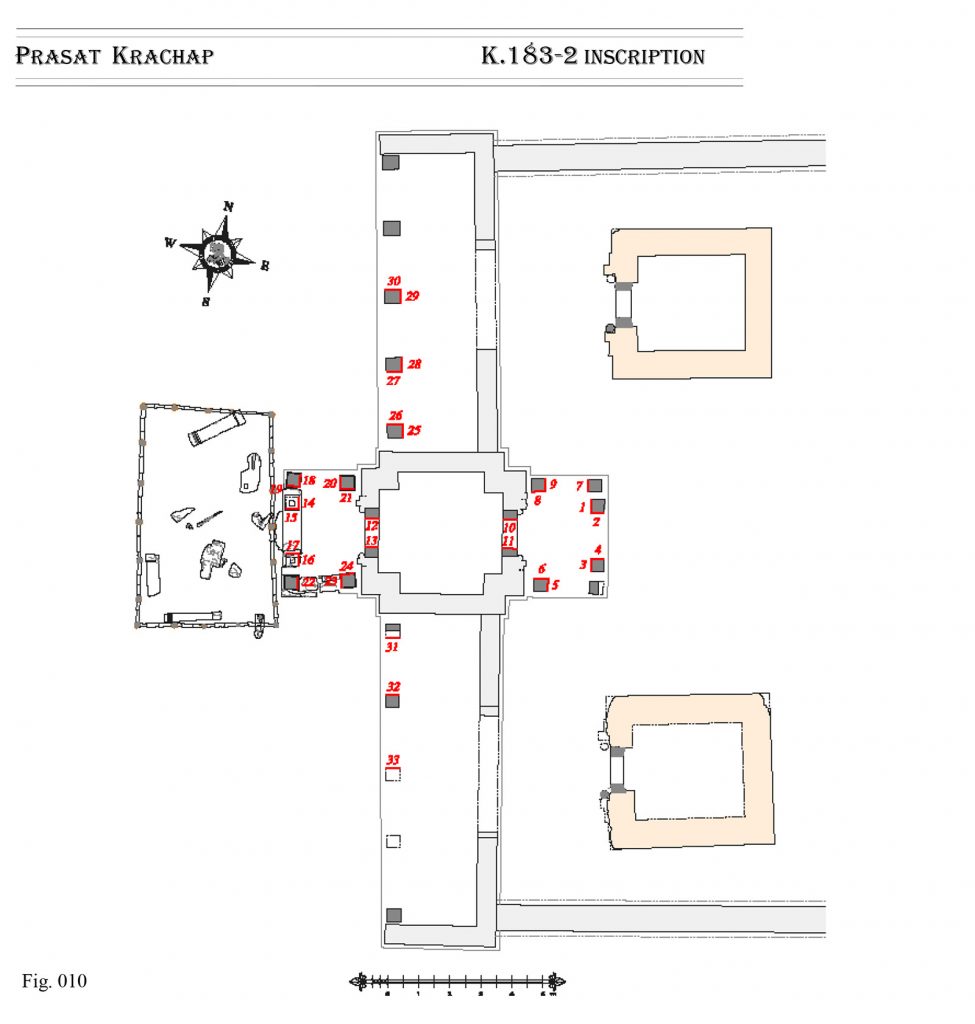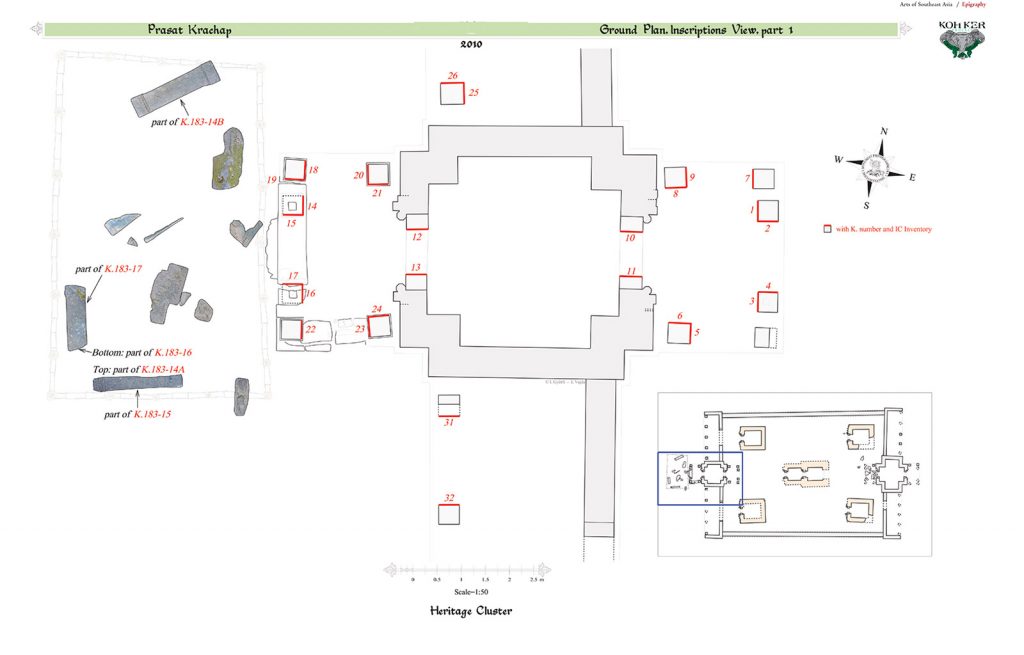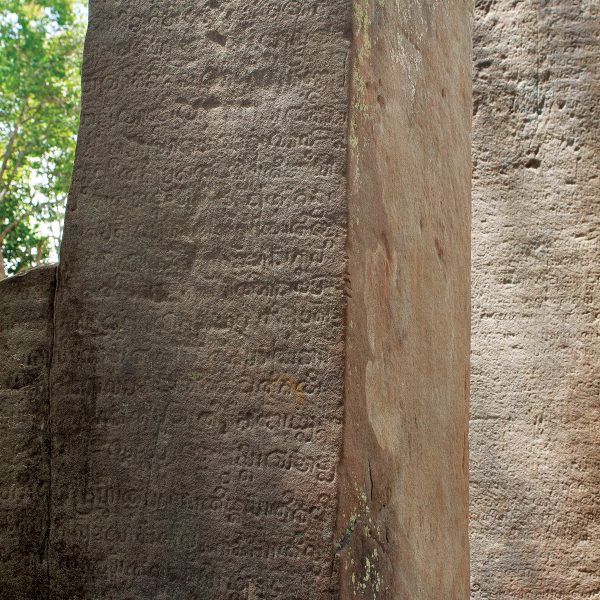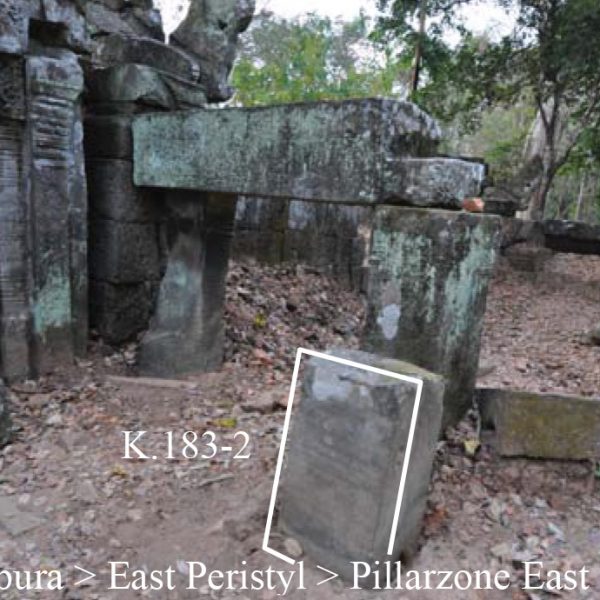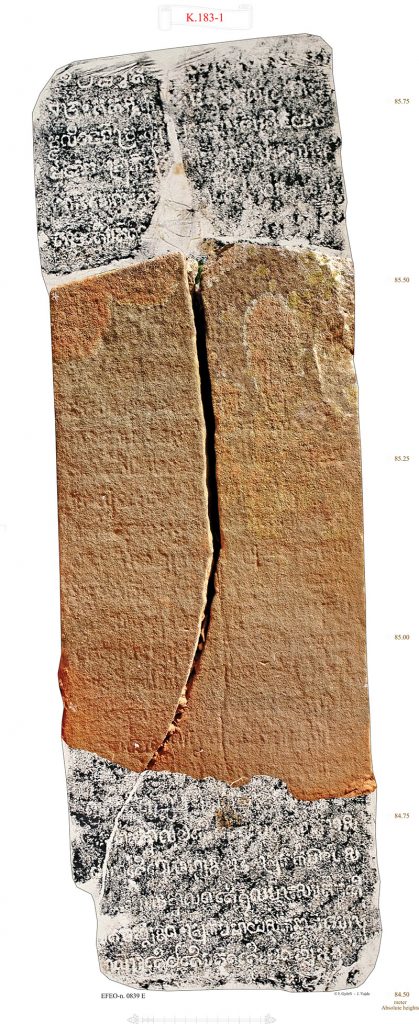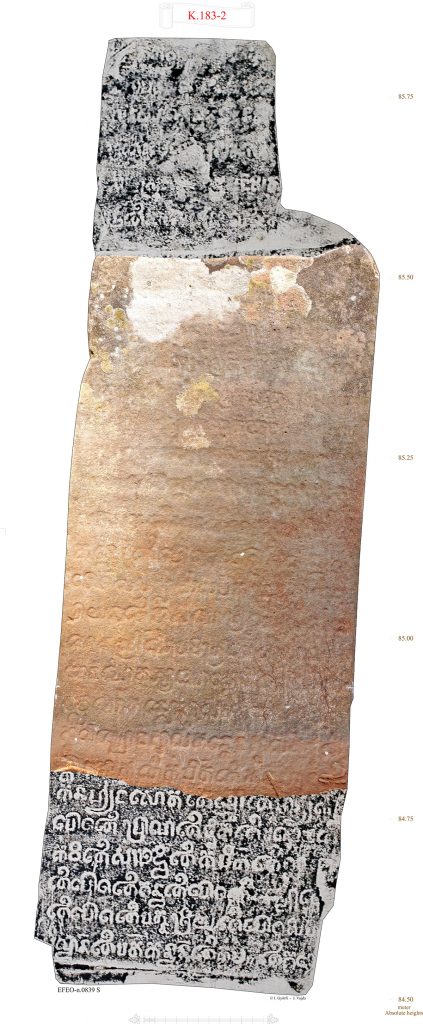Volume 1, Issue 1, March–April 2020.
Rediscovering
the Khmer Inscriptions
by Kunthea Chhom
The written heritage of Koh Ker
Chok Gargyar, the ancient name of Koh Ker, marks a turning point in Angkorian history in the sense that it shows a remarkable advancement in the field of both architecture and epigraphy. It was a city founded by King Jayavarman IV in 921 AD, while King Harshavarman I was ruling at Angkor. During his 20-year reign, Jayavarman IV built many magnificent temples adorned with colossal sculptures. The temples are so different from their predecessors that they have been given their own name, the Koh Ker style. Similarly, the epigraphical vestiges of the region should also be recognized for their linguistic particularity.
In the complex of Koh Ker as a whole, nine temples possess inscriptions, some of which are written in Sanskrit and others in Old Khmer. These inscribed texts throw much light on Khmer society, religion and economy at that time. They are the only source for Cambodian history in the first half of the tenth century. Moreover, the Koh Ker inscriptions contribute enormously to the study of the development of the Khmer language. They were composed during a transitional period when the country enjoyed economic growth. They are actually considered as the forerunners of the literary chef d’oevres of the eleventh century.
Previous literature
The Koh Ker architectural group is famous for its numerous inscriptions: 73 texts have been discovered so far around the complex. Three eminent scholars should be remembered when talking of work on the Koh Ker’s inscriptions – George Coedes and, Saveros Pou nad Claude Jacques. Georges Coedes devoted 25 pages of the Inscriptions du Cambodge, volume I (1937) to Koh Ker’s inscriptions. He has brought to our knowledge the presence of around 60 inscriptions from seven temples – Prasat Thom, Prasat Andong Kuk, Prasat Krachap, Prasat Bantay Pir Chean, Prasat Chen, Prasat Damrei and Prasat Andon.
Of all the inscribed texts, he published three with full transliteration and translation – K 186, K 682 and K 675 and seven with partial transliteration and translation – K 187, K 188, K 189, K 824, K 183, K 680 and K 182. For the rest he simply made brief comments about their condition or their content without giving us the text. In his work, he focused only on the inscriptions that were readable and historically interesting to him. He did not include the exhaustive list of names of the labour force provided for the temples.
Saveros Pou published the Khmer parts of three inscriptions from the Koh Ker Group in her Nouvelles Inscriptions du Cambodge, volume II and III (2001).
The great achievement of the eminent scholar Professor Claude Jacques is that on one hand he made new transliterations and translations of most of the inscriptions that have ever been found at Koh Ker, and on the other hand he used the most important texts in their historical context to write the history of tenthcentury Cambodia (Koh Ker: Temples et Inscriptions, 2014).
Our challenge now is to continue and complete the transliteration of all the inscriptions at Koh Ker (73)—but particularly of all those in old Khmer—on the base of the scientific research work of these three eminent epigraphists and historians of Sanskrit and Old Khmer. The task is to decipher all the readable parts of the inscriptions. In order to correctly decipher the engraved characters, the words should be based on the on both the rubbings made by of the École Française d’Extrême-Orient (EFEO) and the photographs of inscriptions recently taken by the Hungarian Koh Ker Project’s team lead by Dr. Károly Belényesy. The rubbings from the EFEO play a crucial role in the reading because since the time of Coedes publication, i.e. 1937, many texts have been erased by weather and stone decay. It is worth noting that even in Coedes’ day, some inscriptions, such as K 679 and K 677, were entirely or partially ruined. Each vanished inscription is equal to a page of history lost.
A very important part of recent research has been to make a comprehensive translation of the texts either in French or English. Given that the texts, as well as any others written in Old Khmer, are compact and concise, we are obliged to conduct a thorough linguistic study in order to create a meaningful source for historians. Without a clear understanding of each and every word, one cannot estimate the value of the lapidary heritage. The final stage of the research projects is the interpretation. The texts consist mostly of the names of the labour force and servants offered to temples. Many scholars mistakenly underestimate their linguistic value. Pou (2001:93) rightly remarks that ”It is now attested that the Khmer onomastic becomes a part of the lexicon, … and informs us even about professions and ethnicity.” It is, therefore absolutely necessary to carry out a socio-linguistic study in order to throw light on some, if not all, the unresolved lexical enigmas. Some words have always remained obscure. One example is the term ‘antvanae’ (dik) ibid K 682 at Prasat Thom. Being a part of a date, it appears to express the hour. This is also found in three other inscriptions from a different time and place – K 324 at Prasat Lolei, K 383 of Prasat Preah Vihear and K 391 of Nom Van (Thailand). In short, this is socio-linguistic research devoted to a large number of inscriptions from the site.
In the case of Prasat Krachap, to give two concrete examples: the pillar bearing the inscription K 183-1 stands at its original location. The mediocre condition of the inscription prevents us from getting the exact number of lines inscribed on it. A minute study of the rubbing has lead us to the conclusion that it consists of 28 lines
In the transliterated text below, we provide Coedes’ reading of the first four lines in italics. The text starts with a benediction formula inherited from the epigraphy of the city of Hariharalaya (Roulos) and homage to the God Tribhuvanadeva. Next, it records the year of the donation by King Jayavarman IV to the temple, saka 850 (928 A. D.) The year is assigned to be the date of the other thirty-seven inscriptions which are considered to be the continuation of the present one. Despite the missing part, we can claim, by examining the structure of text, that the inscription lists at least eleven villages (struk). After announcing the name of each village, the author gives the name of a mal Dee labourer (si) whereas the rest (gho, gval, tai…) is only in figures.
The Text – English Translation
(1) Fortune! Success! Happiness! Victory!
(2-3) In the saka year 850, His Majesty King Jayavarmmadeva made a royal donations of laborers.
(4-6) Sruk……………Si Vrah ….bhava, 19 male slaves(gho), …47 female slaves(tai) ,…, 4 boys at the age of running(si rat), 9 girls at the age of running(tai rat)…………………………………………………… …………………………..
(7-20) Ruined.
(21) …………, 9 male slaves(gho), __animal keepers(gval), ………………………. ___girls at the age of running————
(22) ———–, female slaves(tai), ————————————————
(23) ———————total————————
(24–25) ————10 animal keepers(gval), 6 female slaves(tai),……………….. …,4 girls at the age of running (tai rat), 1 baby boy(si pau), 2 baby girls (tai pau), total 35 Sruk Kapy- Si …….
(26–28) 4 male slaves(gho), 1 animal keeper(gval), 7 female slaves(tai), 3 Male slaves((lap), 4 boys at the age of running(si rat), 2 girls at the age of running(tai rat), total 21 Druk Pamay – Si Kandac, 2 male slaves (gho), 3 animal keepers(gval), 6 female slaves(tai), 1 girl at the age of running(tai rat), 1 girl, total____.
(1–4) Sruk Bhava__,………………………………………………….., 12 female slaves(tai)… ………………………………………………… .
(5–14) Sruk___Si_______———————————,4___,__ female slaves (tai),——————————,___animal keepers(gval),____female slaves(tai),————————-,__girls at the age of runnig(tai rat), __ –, total___; /van people – 6 male slaves(gho),———————————————-, total ___. Sruk Vap____—————————————- —————–, total 7. Sruk Lanhen———————————————___. Sruk Tannot Chven———————————————————Sruk————————————————————————————
The Text – English Translation
The pillar bearing the inscription K 183-2 is reported in situ. The column leans slightly to the north-east. The upper pillar section has broken off and is missing. The fracture had occurred even before the rubbing was made, at which point a fragment of six inscribed lines was joined to the top of the currently visible column. Its lower section of approximately 26 centimetres (equivalent to six lines of engraved text) is covered with rubble, presumably in good condition, and will be readable after excavation. The remaining inscriptions that we examined in bright light are seriously eroded, but the number of lines can be discerned.
This twenty-nine line text informs us of a pious donation of labour force to the temple from at least five villages. It is believed to be a continuation of K 183-1, thus it is thought to have been composed in saka 850 (928 A.D.) While the first half of the text gives only the figures for the labourers from each village (gho, gval, tai, etc.), the second half generously lists the names of the labourers, male and female alike. Our text becomes more challenging with a term ‘ivan’ [lit. ‘to crawl’] at line 9. Its usage explicitly suggests two sorts of slaves, the ivan people and the common ones.
The Text – English Translation
The Text – English Translation
(1–4) Sruk Bhava___,————————————–,12 female slaves(tai),—————————————————- .
(5–14) Sruk____Si_________——————————, 4___,____ female slaves (tai)————————————————-,___animal keepers (gval),___female slaves(tai),——————————-,
____girls at the age running (tai rat),———-,
total___; the lvan people – six male slaves (gho),—————————————————————-, total____. Sruk Vap____—————————————————-total 7. Sruk Lanlen———————————————————,
total ____. Sruk Tannot Chven———————————————————-, total___, Sruk—————————————————————————————-
(15–29) ————Tai____, Tai Hyan,Tai Tirtha, Tai Kanlen, (accompanied by a baby girl, Tai Phnos, Tai Khmau with a baby girl, Lap Thlay, Lap _____, Lap Narayana, Tai Gmas,
Gho Sri, Gho___, Gho___, Gho Kamvrau Go Pavitra, Gho——————————-, Gho Kambhu, Gho Thgok, Gho ____, Gho Thlem, Gho Kanso, Gval____,
——–, Gval____, Gval Chpon, Gval Kanten,Gval Dharmma, Tai Phka Cok, Tai Kampit, Tai Kanhyan, an other Tai Kanhyan, Tai Khmau, Tai Ajya with a baby girl, Tai Prana, Tai Jvik, Tai Ramnnoc, Tai Kamvi, Tai Samrddhi,Tai Kampit,Tai—————
with a baby girl, Tai Ghandha with baby girl, Si—, (Tai)Pandan with a daughter at teh age of running, nmed Kandan, Tai Kampa–,Tai___
Cited references: Goerges Coedes, Inscriptions du Cambodge, volume I, Hanoi et Paris, EFEO (Collection de textes et documents sur l’Indochine III), 1937 Saveros Pou, Nouvelles Inscriptions du Cambodge, volemes II and III, EFEO, Paris, 2001 Claudes Jacques, Temples et Inscriptions, Budapest, 2014 Kunthea Chhom, Inscriptions of Koh Ker, The Hungarian Southeast Asian Research Institute, Budapest, 2011

